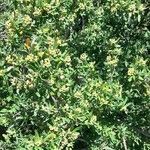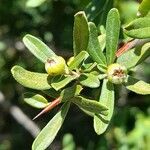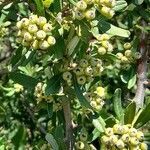Shrubs or small trees, to 4 m tall, often with thorny branches. Branchlets purplish brown when old, densely grayish yellow tomentose when young, glabrous when old. Petiole 1–2.5 mm or leaves sessile; leaf blade narrowly oblong to oblanceolate-oblong, 1.5–5 cm × 4–8 mm, abaxially densely gray tomentose, adaxially initially gray tomentose, soon glabrescent, base cuneate, margin entire, apex obtuse, apiculate, or emarginate. Compound corymb 2–4 cm diam., several flowered; peduncle densely gray tomentose; bracts caducous, lanceolate. Pedicel 1–2 mm, densely gray tomentose. Flowers ca. 2.5 mm in diam. Hypanthium campanulate, densely gray tomentose. Sepals triangular, 1–1.1 mm, abaxially densely gray tomentose, apex acute. Petals suborbicular, ca. 4 mm, apex rounded or emarginate. Stamens 20; filaments 1.5–2 mm. Ovary white tomentose; styles nearly as long as stamens. Pome reddish, depressed-globose, 5–6 mm in diam.; sepals persistent, erect. Fl. May–Jun, fr. Oct–Dec.
Evergreen shrub up to 2.5-(5) m high when mature; stems generally dense and spreading, often spine-tipped; young stems grey-tomentose; older stems reddish brown, shiny. Lf petiole 2-3-(6) mm long, channelled above, tomentose; blade narrowly oblanceolate to oblong, (10)-20-55-(65) × 4-12-(14) mm, obtuse or obscurely retuse with a short mucro, angustate at base, dark green and glabrous above, lanate and pale grey-green below; margin slightly recurved, entire or sometimes with a few minute serrations near tip of largest lvs. Corymbs up to c. 30 mm across; pedicels 6-18 mm long, grey-tomentose. Sepals triangular, c. 0.8 mm long, greyish lanate, acute. Petals obovate or broadly-elliptic, 3.5-5 mm long, rounded, white. Stamens ± = petals. Fr. ± depressed-globose, 4-6 × 6-7 mm, glossy orange.
Plants 20–40 dm. Stems: thorns sparse; young twigs tomentose, hairs dense grayish or yellowish (glabrescent 2d year). Leaves: stipules 4–8 mm; petiole 1–2.5 mm, ?tomentose?; blade narrowly oblong to slightly oblanceolate, 1.5–5 × 0.4–1 cm, base rounded to cuneate, margins entire (sometimes revolute), apex apiculate, obtuse, or retuse, surfaces gray-tomentose (abaxial remaining gray-tomentose, adaxial glabrescent). Inflorescences 2–4 cm diam. Pedicels 1–3 mm, gray-tomentose. Flowers 3–8 mm diam.; hypanthium gray-tomentose; ?calyx persistently gray-tomentose?, sepals triangular, 1 mm, apex acute; petals suborbiculate, 3–4 mm, apex rounded. Pomes red, ?depressed globose?, 4–8 mm diam.; pedicels 2–5 mm.
Evergreen shrub 1.5-3.0 m high; usually spiny; buds small, softly hairy. Leaves alternate, simple, entire, shortly petiolate; stipules minute, caducous. Inflorescence a compound corymb. Flowers white or cream-coloured, bisexual, small. Calyx: tube short; lobes 5, triangular. Petals suborbicular, often with a notched apex. Stamens 20; anthers yellow. Ovary half-inferior; carpels 5, free on central axis, joined on dorsal side for ± 1/2 their length to calyx tube; ovules 2 per carpel; styles free. Fruit small, globose, red, orange or yellow berries, crowned by persistent calyx lobes; pyrenes 5.
Shrub, up to 3 m high; evergreen; young shoots thickly downy; armed. Stems stiff, spiny; spines woody, sharp-pointed with leaves. Leaves simple; blade linear, oblong or narrowly obovate, 10-50 x 4-12 mm, apex obtuse, notched, margins entire or faintly toothed, upper surface dull dark green, glabrous, lower surface greyish tomentose. Flowers: in axillary clusters; calyx hairy; petals ± 5 mm long, dull white; Nov., Dec. Fruit an orange-red or orange-yellow pome, 5-8 mm in diameter.
A shrub. It grows 3.5 m high and spreads 3.5 m wide. It has spines. The branches extend out sideways. The leaves are shiny and dark green. They are grey and furry underneath. There are dense heads of small white flowers. The fruit are yellow to orange berries. They are 1 cm across.
Stiff, upright shrub, up to 4 m high. Leaves linear to oblanceolate, entire, glabrate above, greyish tomentose beneath. Fruits orange-red. Flowers dull white.




